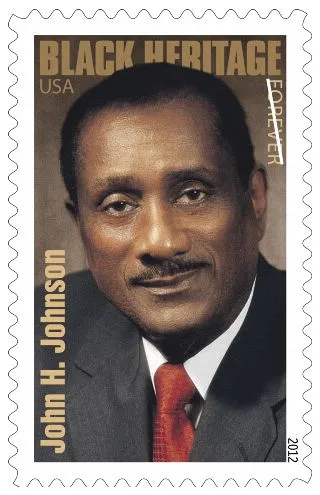JOHN H. JOHNSON, ICONIC PUBLISHER OF JET AND EBONY MAGAZINES, REAPED TREMENDOUS SUCCESS
By Celebrity Boss Staff | January 2023
Legendary entrepreneur John H. Johnson was only 24 years old when he decided to execute his vision of celebrating the Black community by sharing the many achievements found within the community, in addition to its issues. This resulted in the creation and publishing of the early Negro Digest, which ultimately led to the establishment of Johnson Publishing and the iconic Ebony and Jet magazines, which blazed the trail for other Black-oriented publications.
Refusing to listen to naysayers who thought the idea of having a magazine paid for by subscriptions was “virtually unobtainable,” Johnson proved them wrong by publishing the Negro Digest in 1942. He did this with the help of his supportive mother, who allowed him to use her furniture as collateral to get a $500 loan.
Patterned after Reader’s Digest, a popular magazine sharing lifestyle articles geared predominantly towards the white community, Johnson published and distributed the Negro Digest, which covered Black achievement, history, literature, arts, and cultural issues. Correctly believing the concept could become what he considered a “black gold mine,” Johnson saw the magazine's circulation reach 50,000 within the first six months, topping out at about 100,000 in circulation at the height of its success.
Business Collaboration Helped Spark Johnson Early Success
Encountering issues with distribution, Johnson collaborated with a magazine distributor named Joseph Levy, who was impressed with the young visionary and provided marketing tips and helped open doors that allowed Johnson to reach newsstands in other urban centers outside of Chicago, Il. After conceiving the idea of creating a magazine with pictures for and about Black people, Johnson launched Ebony Magazine two years later.
Although Johnson came from humble beginnings, his innate talent, drive, and leadership capabilities helped propel him to early success. Born in Arkansas City, Arkansas, on January 19, 1918, Johnson’s family moved to Chicago, Il., when he was a young boy during the Great Migration of African-Americans out of the South. He attended DuSable High School, where his classmates were other talented and successful African-Americans, like performing artists Nat King Cole, Redd Foxx, and another future entrepreneur, William Abernathy.
Moving to Chicago and seeing middle-class blacks for the first time fueled Johnson’s determination to “make something of himself.” After distinguishing himself in high school with his leadership qualities demonstrated as student council president and as editor of the school paper and class yearbook, Johnson graduated with honors in 1938. He was offered a tuition scholarship to attend the University of Chicago but thought he would have to turn down the scholarship, not knowing how he would pay for his expenses outside of tuition. However, after being invited to give a speech at an Urban League dinner, Johnson caught the attention of Harry Pace, president of the Black-owned Supreme Life Insurance Company, who offered him a job.
Johnson Learned Entrepreneurship from Role Modeling Business Success

Johnson’s work at Supreme Life allowed him to observe how a business is run by a successful African-American, which inspired his dream of starting his own business. Enter the launching of Negro Digest, which led to Ebony Magazine, patterned to look like the popular Life and Look magazines, but which emphasized the achievements of successful Black Americans.
Ebony magazine also included photo essays of current events, race relations, civil rights legislation, marches and all aspects of segregation and discrimination in America. In fact, Ebony Magazine made a point to address the significance of the African-American consumer. The publication’s staff included professional historians, ensuring the contributions of African Americans to the history of the United States could be adequately documented. In addition, African-American models were used in the magazine's advertisements and a conscious effort was made to portray positive aspects of African-American life and culture and within six years, Ebony’s circulation exceeded 450,000 with readers in he United States and abroad.
In 1951, Johnson began publishing Jet Magazine, a weekly news digest and one of Johnson's most notable issues of Jet, was the September 15, 1955 issue in which he published a picture of a Chicago–youth Emmett Till's mutilated body after it had arrived in Chicago from Mississippi. People considered Johnson's decision to publish that photograph of Till, his greatest moment. In fact, Michigan congressman Charles Diggs recalled that given the emotion the image stimulated, it was "probably one of the greatest media products in the last 40 or 50 years."
Johnson Learned Entrepreneurship from Role Modeling Business Success
Although Jet Magazine was also highly successful, Ebony was the shining star of Johnson’s publications and, in its 40th year of publication, had a circulation of 2,300,000. This was the primary reason Johnson was considered among the 400 wealthiest individuals in the United States.Johnson credited his success to the content of his publications because His magazines enjoyed a loyal following. After all, readers could see themselves in a positive light on each page.In an interview with a Chicago newspaper, Johnson said of the success of his publications, “Millions of black people lead normal lives, but until we opened the field, it was little portrayed in the press. From other publications, one would assume that Black men and women never got married, had babies or won beauty contests.” To add to his success, Johnson established several other businesses, including Fashion Fair Cosmetics, the world's number one make-up and skincare company for women of color, and Supreme Beauty hair care products for Black men and women. The company also produced the Ebony Fashion Fair, the world’s largest traveling fashion show, which traveled to more than 200 cities across the U.S., Canada, and the Caribbean and donated nearly $50 million to charity.

Johnson received numerous awards and honorary doctorates for his business achievements, and many schools and universities have been named in his honor. In 1951, he was the first African-American to be selected as Young Man of the Year by the United States Chamber of Commerce; In 1966, he received the Spingam Medal for his contributions in the area of race relations from the National Association for the Advancement of Colored People (NAACP); in 1996, President Bill Clinton bestowed the Presidential Medal of Freedom on Johnson; The Wall Street Journal Dow Jones Entrepreneurial Excellence Award, etc. In addition, on January 31, 2012, the United States Postal Service honored John H. Johnson with a commemorative stamp as part of its Black Heritage Series.’
After more than 50 years of successfully contributing to the success of African-American life and culture through his businesses, Johnson died on August 8, 2005, of congestive heart failure at age 87. More than 3,000 people attended his services, including civil rights leaders like Jesse Jackson, former U.S. President Bill Clinton, and future U.S. President Barack Obama.
The company was passed on to Johnson’s daughter, Linda Rice Johnson. Still, in 2016, Johnson Publishing sold Jet and its sister publication Ebony, to private equity firm Clear View Group, now known as Ebony Media Corporation. The epitome of being young, gifted, and Black, John H. Johnson created and left a powerful and positive entrepreneurial and cultural legacy, which is still revered today.

Follow Us On
© 2023-2022 Celebrity Boss Inc., All Rights Reserved.